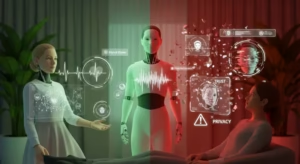AI in Mental Health: Can Algorithms Understand the Human Psyche?

The blog post explores the role of AI in mental health, examining how algorithms are being developed to understand the complexities of the human psyche. It highlights the benefits of AI therapy, such as increased accessibility and personalized treatment options, while also addressing the challenges, including ethical considerations and the need for human oversight. The piece discusses how AI counseling tools are transforming the mental health landscape, offering innovative solutions that could complement traditional therapy. Finally, it outlines the next steps necessary for the effective integration of AI in mental health practices, emphasizing the importance of collaboration between technology and mental health professionals. Ultimately, the article provides a comprehensive overview of AI in mental health, illustrating its potential to enhance mental well-being while acknowledging the need for careful implementation.
Understanding The Role Of AI In Mental Health

The integration of AI in mental health represents a revolutionary shift in how we approach psychological care. With the rise of digital psychiatry, technology has provided new avenues for assessment, diagnosis, and treatment. AI algorithms utilize vast amounts of data to uncover patterns that might elude even the most seasoned professionals, making it a valuable tool in identifying mental health issues early and accurately. AI’s role goes beyond traditional therapy methods to offer insights that enhance understanding of the human psyche, paving the way for personalized treatment plans and monitoring tools that adapt to individual needs.
Explore The Applications Of AI In Mental Health
- Predictive analytics for early intervention.
- Chatbots for immediate support and guidance.
- Emotion recognition software to assess patient moods.
- Virtual reality therapy for phobia treatments.
- Data-driven therapy recommendations based on patient history.
- Automated follow-ups to ensure ongoing patient engagement.
- Support for clinicians through enhanced diagnostic tools.
As the capabilities of AI in mental health continue to grow, clinicians and therapists are increasingly relying on these tools to improve patient outcomes in digital psychiatry. However, as with any emerging technology, ethical considerations around privacy, consent, and the potential for misdiagnosis must be carefully evaluated. Adopting AI within mental health practices can enhance the therapeutic relationship, allowing for more efficient monitoring of patient progress while simultaneously enabling practitioners to focus on delivering high-quality human-centered care.
Benefits And Challenges Of AI Therapy In Mental Health

The integration of AI therapy in mental health care presents a paradigm shift in addressing emotional and psychological issues. With the ability to analyze patterns in behavior and emotions through advanced algorithms, AI systems are now capable of offering support that can complement traditional therapy. However, while there are promising future prospects, it is essential to consider both the benefits and challenges that this technology brings to mental health practitioners and clients alike.
One of the major advantages of AI therapy is its ability to facilitate emotion recognition. This technology enables systems to identify and interpret human emotions from various inputs, including text, voice, and facial expressions. As a result, AI can provide immediate feedback and assistance during moments of distress. Additionally, the scalability of AI solutions allows for wider accessibility in mental health services, which is pivotal for populations with limited access to traditional therapy options.
Overview of AI Therapy Benefits and Challenges
| Aspect | Benefits | Challenges |
|---|---|---|
| Scalability | Increased access to mental health support | Still requires human oversight for nuanced cases |
| Emotion Recognition | Immediate emotional feedback | Potential for misinterpretation of emotions |
| Cost-Effectiveness | Reduced operational costs for institutions | High initial development investment |
| Data Insights | Improved outcomes through data analysis | Privacy concerns regarding user data |
Despite the numerous advantages, AI therapy faces significant challenges that need to be addressed for its successful integration into mental health practices. One of the most pressing issues is the ethical considerations surrounding patient data and privacy. Trust is paramount in therapeutic relationships, and patients may feel uncomfortable sharing sensitive information with an AI system. Furthermore, the lack of emotional nuance in understanding complex human behaviors could lead to inadequate responses in critical situations.
Key Benefits Of AI Therapy
The benefits of AI in mental health extend beyond just face value. AI therapy enhances the therapeutic experience through:
- Accessibility: Providing mental health support to remote and underserved areas.
- 24/7 Availability: Offering assistance at any time, allowing users to engage as per their comfort.
- Consistency: Delivering uniform responses that can be continually improved upon.
Challenges Faced By AI Therapy
On the other hand, it is crucial to be aware of the hurdles that AI therapy encounters:
- Accuracy of Emotion Detection: Issues may arise from misinterpretation or lack of empathy.
- Regulatory Hurdles: Compliance with mental health regulations and standards.
- Resistance from Traditional Practitioners: Concerns over the efficacy of AI-based treatment.
Steps To Implement AI Therapy
- Identify Key Objectives: Define what needs AI therapy to accomplish.
- Choose Appropriate Tools: Select reliable AI frameworks and technologies.
- Piloting the System: Test AI solutions in a controlled environment with real users.
- Gather Feedback: Regularly solicit input from users and practitioners to improve services.
- Train Practitioners: Ensure traditional therapists are prepared to work alongside AI solutions.
- Monitor Outcomes: Continuously measure the effectiveness of AI interventions.
- Adapt and Evolve: Stay flexible to incorporate new insights and technologies over time.
In conclusion, the journey of integrating AI in mental health is filled with both promising benefits and significant challenges. Recognizing these aspects is essential for mental health professionals looking to enhance their practice through innovative technology.
How AI Counseling Tools Are Changing The Landscape Of Mental Health

AI counseling tools are revolutionizing the way mental health services are delivered, significantly impacting both patients and professionals in the field. These advanced digital psychiatry solutions can analyze user inputs, recognize patterns in behavior, and provide personalized feedback, making them a valuable asset for therapy. Moreover, they have the potential to reach individuals who may not have access to traditional mental health services, enabling better mental health support across diverse populations.
Popular AI Counseling Tools
- Woebot: A conversational agent that uses AI to provide emotional support.
- Wysa: An AI-driven chatbot that offers therapy techniques and coping strategies.
- Replika: A virtual companion that encourages emotional expression and personal growth.
- Mindstrong: An app that tracks behaviors and moods to provide insights on mental health.
- Ginger: A platform that combines AI with human coaches for on-demand support.
- K Health: A service that offers both medical answers and mental health resources through AI.
As these AI counseling tools continue to evolve, they reflect a broader trend towards integrating technology in mental health treatment. Predictive analytics and machine learning algorithms allow these tools to adapt to individual user needs, ensuring more tailored interventions. While many users report positive experiences, there are discussions surrounding the ethics and accuracy of AI in mental health. Critics raise concerns regarding data privacy and the necessity of maintaining a human touch in therapy.
Case Study: Effective AI Counseling Tools
One notable case study involves the use of Woebot, an AI-driven chatbot designed to assist users in managing their emotions and mental well-being. Users engaging with Woebot report improved emotional awareness and coping mechanisms. As a digital psychiatry tool, Woebot utilizes Cognitive Behavioral Therapy (CBT) principles to offer instant support, which has proven effective for many. Such examples highlight the potential of AI counseling tools in making psychological assistance more accessible, particularly for those hesitant to seek traditional therapy options.
“The rise of AI in mental health represents a significant shift in the availability and delivery of mental health services, balancing technology and human interaction.”
Next Steps For Integrating AI In Mental Health Practices

As mental health practices increasingly adopt technology, AI in mental health emerges as a powerful tool in enhancing care delivery. The integration of AI therapy can streamline processes, improve client engagement, and offer personalized treatment plans based on individuals’ needs. For healthcare providers, the next steps include establishing protocols for implementing these technologies, ensuring compliance with ethical standards, and training professionals to work alongside AI systems to create a seamless care process.
Actionable Steps For Integration
- Conduct thorough research on available AI tools and their efficacy in mental health.
- Develop a clear strategy for integration that aligns with your practice’s needs.
- Secure funding and support for infrastructure updates required for AI adoption.
- Provide training sessions for clinicians to effectively utilize AI in therapy.
- Implement pilot programs to evaluate the success of AI applications.
- Gather feedback from both clients and practitioners to refine AI use.
- Continuously update protocols based on the evolving landscape of AI technologies.
Ultimately, these actionable steps will guide mental health practices toward effectively harnessing AI in mental health. By committing to ongoing education and evaluation, practitioners can ensure that the technology serves to enhance rather than replace the human element in therapy, allowing AI therapy to flourish as a valuable supplement to traditional methods.
Briefing Document: The Role of AI in Mental Health
Homepage / humanaifuture.com
For similar articles, please visit: AI and Human Mind & Psychology
🎧 Listen to the Podcast
Want to explore this topic in more depth? Listen to the full podcast for more insights and expert commentary.
▶️ Play on Google DriveNo sign-up needed — just click and listen.
What are the main benefits of integrating AI into mental health therapy?
The integration of AI into mental health therapy offers several significant benefits. It increases accessibility to mental health support, particularly for remote and underserved areas, and provides 24/7 availability. AI systems can offer consistent responses that can be continuously improved upon and aid in immediate emotional feedback through emotion recognition. Furthermore, AI can reduce operational costs for institutions and provide improved outcomes through comprehensive data analysis.
What are the key challenges and ethical considerations surrounding AI therapy?
Despite its advantages, AI therapy faces substantial challenges and ethical considerations. A primary concern is patient data privacy and security, as sharing sensitive information with AI systems can be uncomfortable for users. There's also the potential for misinterpretation of complex human emotions and behaviors due to the lack of emotional nuance in AI, which could lead to inadequate responses in critical situations. Other challenges include regulatory hurdles, high initial development costs, and potential resistance from traditional practitioners who may doubt the efficacy of AI-based treatments.
How do AI counseling tools specifically impact the delivery of mental health services?
AI counseling tools are fundamentally changing how mental health services are delivered by providing advanced digital solutions that analyze user inputs, recognize behavioral patterns, and offer personalized feedback. Tools like Woebot, Wysa, and Replika provide immediate emotional support, therapy techniques, and foster personal growth. They make psychological assistance more accessible, especially for individuals hesitant to seek traditional therapy, and can adapt to individual user needs through predictive analytics and machine learning.
Can AI effectively understand the human psyche, or is human oversight still necessary?
While AI algorithms can utilize vast amounts of data to uncover patterns in behavior and emotions, enhancing the understanding of the human psyche, they currently require human oversight. The source emphasizes the need for careful implementation and collaboration between technology and mental health professionals. AI can complement traditional therapy by providing insights and support, but the lack of emotional nuance and the complexities of human behavior necessitate human intervention for nuanced cases and critical situations to ensure high-quality, human-centered care.
What popular AI counseling tools are currently in use, and what do they offer?
Several popular AI counseling tools are changing the mental health landscape:
- Woebot: An AI-driven chatbot that uses Cognitive Behavioral Therapy (CBT) principles to help users manage emotions.
- Wysa: An AI chatbot offering therapy techniques and coping strategies.
- Replika: A virtual companion designed to encourage emotional expression and personal growth.
- Mindstrong: An app that tracks behaviors and moods to provide mental health insights.
- Ginger: A platform combining AI with human coaches for on-demand support.
- K Health: A service that provides medical answers and mental health resources via AI.
What actionable steps are necessary for the effective integration of AI in mental health practices?
Effective integration of AI in mental health practices requires several actionable steps:
- Conduct thorough research on available AI tools and their efficacy.
- Develop a clear integration strategy aligned with practice needs.
- Secure funding and support for infrastructure updates.
- Provide comprehensive training for clinicians to effectively utilize AI.
- Implement pilot programs to evaluate AI application success.
- Gather feedback from both clients and practitioners for refinement.
- Continuously update protocols based on evolving AI technologies. These steps aim to enhance care delivery while maintaining the human element in therapy.
How does AI therapy enhance the therapeutic experience beyond traditional methods?
AI therapy enhances the therapeutic experience beyond traditional methods by providing increased accessibility (especially to remote areas), 24/7 availability for support, and consistency in responses. It facilitates immediate emotional feedback through emotion recognition and offers personalized treatment plans based on data-driven insights. By handling routine tasks and providing diagnostic support, AI allows practitioners to focus on delivering high-quality, human-centered care, complementing and improving the efficiency and reach of traditional therapy.




